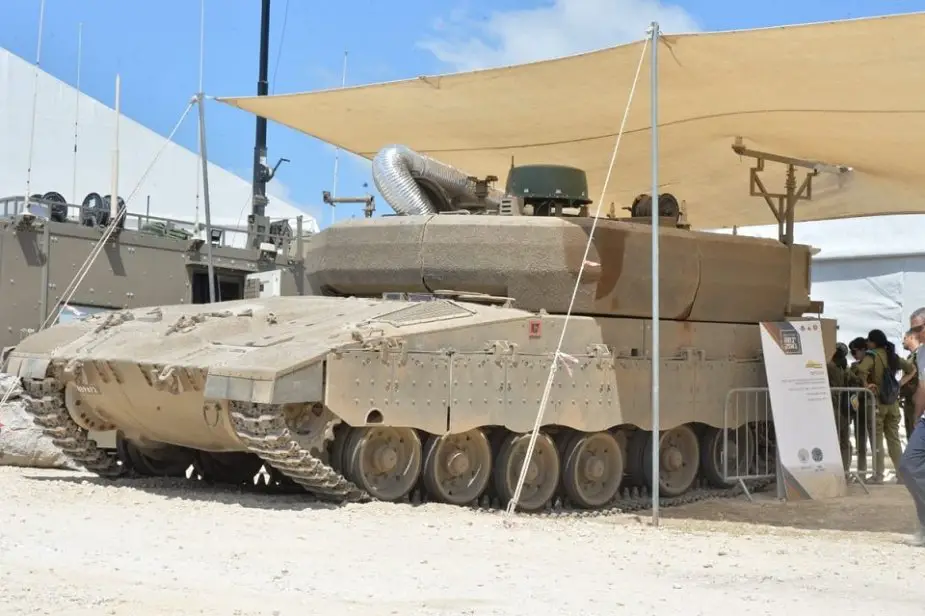Israel: Elbit X Ray vision for Merkava tank crews, updated armored command vehicle
As reported by Joseph Trevithick on WarZone, pictures have emerged of what appears to be an updated command vehicle variant of the Israeli Army’s Ofek (“Horizon”) armored vehicle, which is a derivative of the Merkava tank. The new development comes as Israel pushes ahead with a major upgrade program for the Merkava itself, which will include an augmented reality system that will allow the crew to “see” in any direction outside without having to leave the vehicle and expose themselves to hostile fire and an artificial intelligence-enabled mission computer.

Ofek, the new command vehicle, is based on a Merkava II chassis (Picture source: IDF)
On August 28, 2018, multiple users on Twitter posted images of the latest version of Ofek, which means “horizon” in Hebrew. The IDF indicates the vehicle is specifically designed for command and control purposes. Ofek features a large, fixed superstructure on top of a modified Merkava hull and chassis. The available images show the latest examples bristling with radio aerials and vehicle in Binnie’s picture also had what looks to be a large, round satellite communications antenna on top.
A side-by-side shot of one of them next to an older command vehicle based on the M113 armored personnel carrier, shows that the Ofek is significantly larger. It is likely able to carry more radios and other communications gear, as well as cooling systems for both the equipment and the crew inside cool. A picture shows an air conditioning hose going into the vehicle through a hatch on the roof. This is likely only necessary for display, where the engine or any auxiliary power units won't be running to power the onboard systems but gives a sense of how hot the inside would otherwise get.
The Israeli Army reportedly began testing the first Ofek prototypes all the way back in 2015, but at that time the vehicle’s main mission was as a heavy armored personnel carrier for support units, such as combat engineers. There were also plans to use the added space to turn them into armored ambulances and cargo carriers. The concept offered Israel a means of recycling old Merkava Mk IIs, which were starting to leave service at that time. The Israelis planned to have these tanks retired entirely by the end of 2016.
This latest version of Ofek is still likely to be an important addition to Israeli armored formations. Between the satellite antenna and the radio equipment, the vehicle and its crew look to be able to create an active network for any other tanks or other armored vehicles in its vicinity. The U.S. Army, among other military forces, is working along similar lines to implement an on-the-go high-bandwidth satellite connectivity capability.
With these links to larger, overarching communications and data-sharing networks, Ofek could offer a secure and physically protected satellite uplink and local network relay, which would give Israeli units a significant advantage over opponents in both limited and larger scale conventional conflicts. Line-of-sight communications, in particular, quickly begin to suffer in dense urban areas and across complex terrain, such as hills and mountains, which are exactly the kinds of environments the IDF routinely fights in.
The new iteration of Ofek also looks set to be a significant complement to the Israeli Army's planned upgrades to their existing Merkava Mk IVs. By 2021, the Israeli Army hopes to receive its first production Mk IV Barak tanks. The main new feature of this variant, which the IDF unveiled in July 2018, is the integration of Elbit’s Iron Vision helmet-mounted augmented reality system. This will be linked to a series of high-resolution cameras arrayed around the tank.
The existing Mk IV has a number of more traditional optics, as well as the ability to receive full-motion video and other data from unmanned aircraft and other sources, but still offers limited visibility for the crew when they're "buttoned up" inside with all the hatches closed, a long-standing issue for tanks and other armored vehicles in general. Iron Vision will give the crew immensely better situational awareness in any direction without the need for that offboard assistance.
Similar to the F-35 “Lightning II” Joint Strike Fighter’s AN/AAQ-37 Distributed Aperture System, the system will “stitch together” those feeds together and project them onto the helmet's visor, giving crew members the ability to rapidly “see” in any direction from within the safety of the tank. This will also be especially valuable for urban operations, which inherently offer hostile forces multiple avenues to quickly attack a tank's blind spots and then duck back behind cover. The Mk IV Barak is getting an improved version of Trophy to help guard against those threats, as well.
The Mk IV Barak will also have improved network connectivity, allowing the vehicle to share a much broad array of information and do so rapidly. There will also be a new artificial intelligence-assisted mission computer to reduce the workloads for individual crew members, help them sift through sensor data and other information faster, and otherwise speed up the decision making and targeting processes. “The mission computer will be like a fifth crew member, which will improve processes in the cabin,” an IDF officer sid. “It’s designed to understand the situation and activate multiple touchscreens accordingly. This will form an inseparable part of the ability to conduct combat operations in closed, urban spaces.”
Given the heavily networked nature of the Mk IV Baraks, Ofek could serve as a vital communications conduit and relay for other data between the tanks other forces, including those on the ground, in the air, or at sea.





























